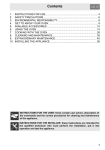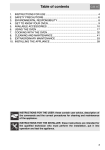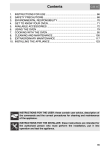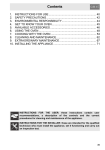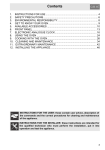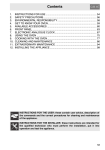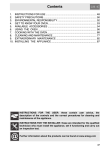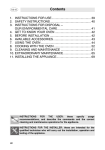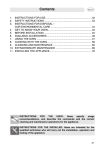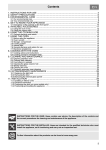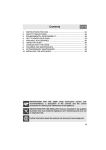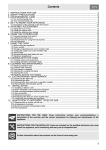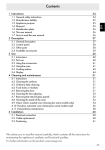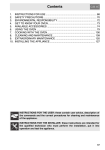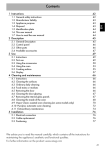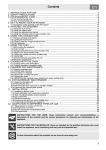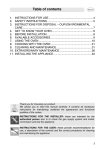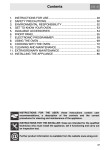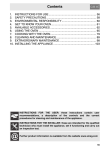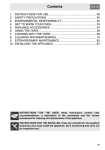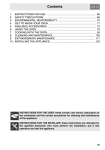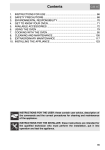Download Smeg SCP490N-8
Transcript
Contents 1. 2. 3. 4. 5. 6. 7. 8. 9. 10. 11. INSTRUCTIONS FOR USE ......................................................................... 46 SAFETY PRECAUTIONS ............................................................................ 48 ENVIRONMENTAL RESPONSIBILITY ........................................................ 50 GET TO KNOW YOUR OVEN...................................................................... 51 AVAILABLE ACCESSORIES ....................................................................... 52 FRONT PANEL ............................................................................................ 55 USING THE OVEN ...................................................................................... 58 COOKING WITH THE OVEN....................................................................... 67 CLEANING AND MAINTENANCE ............................................................... 74 EXTRAORDINARY MAINTENANCE ........................................................... 79 INSTALLING THE APPLIANCE ................................................................... 83 INSTRUCTIONS FOR THE USER: these contain user advice, description of the commands and the correct procedures for cleaning and maintenance of the appliance. INSTRUCTIONS FOR THE INSTALLER: these instructions are intended for the qualified technician who must perform the installation, put it into operation and test the appliance. 45 General instructions 1. INSTRUCTIONS FOR USE THIS MANUAL IS AN INTEGRAL PART OF THE APPLIANCE. IT MUST BE KEPT IN ITS ENTIRETY AND IN AN ACCESSIBLE PLACE FOR THE WHOLE WORKING LIFE OF THE APPLIANCE. CAREFUL READING OF THIS MANUAL AND ALL THE INSTRUCTIONS THEREIN BEFORE USING THE APPLIANCE IS ESSENTIAL. INSTALLATION MUST BE CARRIED OUT BY COMPETENT PERSONS IN ACCORDANCE WITH THE REGULATIONS IN FORCE. THIS APPLIANCE IS INTENDED FOR HOUSEHOLD USE AND COMPLIES WITH THE EEC DIRECTIVES CURRENTLY IN FORCE. THE APPLIANCE HAS BEEN BUILT TO CARRY OUT THE FOLLOWING FUNCTIONS: COOKING FOOD; ALL OTHER USES ARE CONSIDERED UNSUITABLE. THE MANUFACTURER CANNOT BE HELD LIABLE FOR USE OTHER THAN AS INDICATED. THIS APPLIANCE HAS BEEN MANUFACTURED TO COOK FOOD, DO NOT USE THE APPLIANCE TO HEAT ROOMS. THIS APPLIANCE IS MARKED ACCORDING TO EUROPEAN DIRECTIVE 2002/96/EC ON WASTE ELECTRICAL AND ELECTRONIC EQUIPMENT (WEEE). THIS DIRECTIVE DEFINES THE STANDARDS FOR THE COLLECTION AND RECYCLING OF WASTE ELECTRICAL AND ELECTRONIC EQUIPMENT APPLICABLE THROUGHOUT THE EUROPEAN UNION. NEVER OBSTRUCT THE OPENINGS AND SLITS PROVIDED FOR VENTILATION AND HEAT DISPERSAL. DO NOT REST ANY WEIGHT OR SIT ON THE OPEN DOOR OF THE APPLIANCE. THE IDENTIFICATION PLATE WITH THE TECHNICAL DATA, SERIAL NUMBER AND BRAND NAME HAS BEEN VISIBLY AFFIXED TO THE APPLIANCE. DO NOT REMOVE THIS PLATE FOR ANY REASON. BEFORE THE APPLIANCE IS PUT INTO OPERATION, ALL THE PROTECTIVE FILMS APPLIED INSIDE OR OUTSIDE MUST BE REMOVED. TAKE CARE THAT NO OBJECTS ARE STUCK IN THE DOOR OF THE OVEN. THE APPLIANCE BECOMES VERY HOT DURING USE. SUITABLE HEAT-PROOF GLOVES SHOULD BE WORN FOR ALL OPERATIONS. 46 General instructions DO NOT USE METALLIC SPONGES AND SHARP SCRAPERS AS THEY WILL DAMAGE THE SURFACES. USE NORMAL NON-ABRASIVE PRODUCTS, INCLUDING WOODEN OR PLASTIC UTENSILS IF NECESSARY. RINSE THOROUGHLY AND DRY USING A SOFT CLOTH OR CHAMOIS LEATHER. DO NOT ALLOW RESIDUES OF SUGARY FOODS (SUCH AS JAM) TO SET INSIDE THE OVEN. IF THEY ARE ALLOWED TO SET FOR TOO LONG, THEY COULD RUIN THE ENAMEL COVERING THE INSIDE OF THE OVEN. DO NOT USE PLASTIC KITCHENWARE OR CONTAINERS. THE HIGH TEMPERATURES INSIDE THE OVEN COULD MELT THE PLASTIC, DAMAGING THE APPLIANCE. DO NOT USE SEALED TINS OR CONTAINERS IN THE APPLIANCE. OVERPRESSURE MAY OCCUR INSIDE THE CONTAINERS DURING COOKING, CREATING A DANGER OF EXPLOSION. DO NOT LEAVE THE APPLIANCE UNATTENDED DURING COOKING PROCESSES WHERE FATS OR OILS COULD BE RELEASED. FATS AND OILS MAY CATCH FIRE. DO NOT COVER THE BOTTOM OF THE OVEN WITH ALUMINIUM OR TINFOIL SHEETS DURING COOKING AND DO NOT PLACE PANS OR TRAYS ON IT TO AVOID DAMAGE TO THE ENAMELLED SURFACE. IF THE SURFACES ARE STILL VERY HOT DURING COOKING, DO NOT POUR WATER DIRECTLY ONTO THE TRAYS. THE STEAM COULD CAUSE SEVERE BURNS AND DAMAGE TO ENAMELLED SURFACES. ALL COOKING OPERATIONS MUST TAKE PLACE WITH THE DOOR CLOSED. 47 General instructions 2. SAFETY PRECAUTIONS REFER TO THE INSTALLATION INSTRUCTIONS FOR THE SAFETY REGULATIONS FOR ELECTRIC OR GAS APPLIANCES AND VENTILATION FUNCTIONS. IN YOUR INTERESTS AND FOR YOUR SAFETY THE LAW REQUIRES THAT THE INSTALLATION AND SERVICING OF ALL ELECTRICAL APPLIANCES ARE CARRIED OUT BY QUALIFIED PERSONNEL IN ACCORDANCE WITH THE REGULATIONS IN FORCE. OUR APPROVED INSTALLERS GUARANTEE A SATISFACTORY JOB. GAS OR ELECTRICAL APPLIANCES MUST ALWAYS BE DISCONNECTED BY SUITABLY SKILLED PEOPLE. BEFORE CONNECTING THE APPLIANCE TO THE POWER GRID, CHECK THE DATA ON THE PLATE AGAINST THE DATA FOR THE GRID ITSELF. BEFORE CARRYING OUT INSTALLATION / MAINTENANCE WORK, MAKE SURE THAT THE APPLIANCE IS NOT CONNECTED TO THE POWER GRID. THE PLUG TO BE CONNECTED TO THE POWER SUPPLY CABLE AND ITS SOCKET MUST BE OF THE SAME TYPE AND CONFORM TO THE REGULATIONS IN FORCE. THE SOCKET MUST BE ACCESSIBLE AFTER THE APPLIANCE HAS BEEN BUILT-IN. NEVER DISCONNECT THE PLUG BY PULLING ON THE CABLE. IF THE POWER SUPPLY CABLE IS DAMAGED, CONTACT THE TECHNICAL SUPPORT SERVICE IMMEDIATELY AND THEY WILL REPLACE IT. IT IS OBLIGATORY FOR ALL ELECTRICAL EQUIPMENT TO BE EARTHED ACCORDING TO THE METHODS LAID DOWN BY SAFETY REGULATIONS. IMMEDIATELY AFTER INSTALLATION CARRY OUT A BRIEF INSPECTION TEST, FOLLOWING THE INSTRUCTIONS BELOW. SHOULD THE APPLIANCE NOT FUNCTION, DISCONNECT IT FROM THE ELECTRICITY SUPPLY AND CALL THE NEAREST TECHNICAL SUPPORT CENTRE. NEVER ATTEMPT TO REPAIR THE APPLIANCE. DO NOT USE OR LEAVE FLAMMABLE MATERIALS NEAR THE APPLIANCE OR IN THE FOOD WARMING COMPARTMENT. DURING USE THE APPLIANCE BECOMES VERY HOT. TAKE CARE NOT TO TOUCH THE HEATING ELEMENTS INSIDE THE OVEN. THIS APPLIANCE MAY NOT BE USED BY PEOPLE (INCLUDING CHILDREN) OF REDUCED PHYSICAL AND MENTAL CAPACITY, OR LACKING IN EXPERIENCE IN THE USE OF ELECTRICAL APPLIANCES, UNLESS THEY ARE SUPERVISED OR INSTRUCTED BY ADULTS RESPONSIBLE FOR THEIR SAFETY. 48 General instructions DO NOT LET CHILDREN GO NEAR THE APPLIANCE WHEN IT IS IN OPERATION OR PLAY WITH IT AT ANY TIME. DO NOT INSERT POINTED METAL OBJECTS (CUTLERY OR UTENSILS) INTO THE SLITS IN THE APPLIANCE. IF THE APPLIANCE IS INSTALLED ON CARAVANS OR BOATS, IT MUST NOT BE USED TO HEAT ROOMS. DO NOT USE STEAM JETS FOR CLEANING THE APPLIANCE. THE STEAM COULD REACH THE ELECTRONICS, DAMAGING THEM AND CAUSING SHORT-CIRCUITS. DO NOT MODIFY THIS APPLIANCE. DO NOT SPRAY ANY SPRAY PRODUCTS NEAR THE ELECTRICAL APPLIANCE WHILE IT IS IN OPERATION. DO NOT USE SPRAY PRODUCTS WHILE THE PRODUCT IS STILL HOT. The manufacturer cannot be held liable for damage to persons or things caused by failure to observe the above instructions, by interference with any part of the appliance or by the use of non-original spare parts. 49 Instructions for disposal 3. ENVIRONMENTAL RESPONSIBILITY 3.1 Our environmental responsibility Pursuant to Directives 2002/95/EC, 2002/96/EC and 2003/108/EC relating to the reduction of the use of hazardous substances in electrical and electronic appliances, as well as to the disposal of refuse, the crossed out bin symbol on the appliance indicates that at the end of the useful life of the product, it must be collected separately from other refuse. Therefore, at the end of the product's working life, the user must deliver it to the appropriate differentiated collection centres for electrical and electronic waste, or deliver it back to the retailer when purchasing an equivalent product, on a one-for-one basis. Adequate differentiated collection for the subsequent forwarding of the decommissioned product to recycling, processing and ecologically compatible disposal contributes to avoiding possible negative effects on the environment and on health, and promotes recycling of the appliance's constituent materials. Illicit disposal of the product by the user will lead to the application of administrative sanctions. The product does not contain substances in quantities sufficient to be considered hazardous to health and the environment, in accordance with current European directives. 3.2 Your environmental responsibility Our product's packing is made of non-polluting materials, which are therefore compatible with the environment and recyclable. Please help by disposing of the packaging correctly. You can obtain the addresses of collection, recycling and disposal centres from your retailer or from the competent local organisations. Do not discard the packaging or any part of it, or leave it unattended. It can constitute a suffocation hazard for children, especially the plastic bags. Your old appliance also needs to be disposed of correctly. Important: hand over your appliance to the local agency authorised for the collection of electrical appliances no longer in use. Correct disposal enables intelligent recovery of valuable materials. Before disposing of your appliance it is important to remove doors and leave shelves in the same position as for use, to ensure that children cannot accidentally become trapped inside during play. It is also necessary to cut the connecting cable to the power grid, removing it along with the plug. 50 Instructions for the user 4. GET TO KNOW YOUR OVEN MULTIFUNCTION 1 90 5 15 80 25 70 60 35 45 0 50 250 220 200 ECO 90 120 160 2 5 3 6 7 1 P 0 ECO ECO P PYROLYTIC 4 2 5 3 6 7 Control panel Drawn runners Bulb Oven fan Rotisserie Oven seal Roof liner 51 Instructions for the user 5. AVAILABLE ACCESSORIES NOTE: Some models are not provided with all accessories. Rack: for holding cooking containers. Tray rack: to be placed over the top of the oven tray; for cooking foods which may drip. Oven tray: for collecting fat from foods placed on the rack above. Deep oven tray: for baking cakes, pizza and oven desserts. Rotisserie frame (on some models only): supports the rotisserie rod. Rotisserie rod (on some models only): for cooking chicken and all foods which require uniform cooking over their entire surface. Accessories available on request: Original supplied and optional accessories may be ordered from any Authorised Support Centre. Use original SMEG accessories only. 52 Instructions for the user 5.1 Using the racks The racks are equipped with a mechanical safety lock which prevents them from being taken out accidentally. To insert the rack correctly, check that the lock is facing downwards (as shown in the figure). To take it out, lift the front edge of the rack slightly while sliding it out on the side runners. The mechanical lock must always face the back of the oven. Insert racks and trays fully into the oven until they come to a stop. 5.2 Using the support rack The support rack is inserted into the tray (as shown in the figure). Using this, foods can be cooked and the fat can be collected separately from the food which is being cooked. 53 Instructions for the user When cooking with the rotisserie, position the frame on the third runner (see 7.2.2 Oven runners). Once the frame is inserted, the shaped part must sit facing outwards (as shown in the figure). Then prepare the rotisserie rod with the food, using the clip forks provided. So that you can handle the rod with the food on it readily, screw on the handle provided. Having prepared the rotisserie rod with the food, position it on the guide frame as shown in the figure. Insert the rod into the hole (detail B) so that it connects with the rotisserie motor. Make sure that the pin is placed correctly on the guide frame (detail A). 54 3 Instructions for the user 6. FRONT PANEL PYROLYTIC MULTIFUNCTION All the controls and indicator lights can be seen on the front panel. The tables below describe the symbols used. 1 2 90 5 15 80 25 70 60 35 45 5 3 4 0 50 ECO 90 250 220 200 120 160 6 4 P 0 ECO ECO P TIMER KNOB (on some models only) This knob enables manual cooking or the timer to be selected; the timer switches off the oven automatically at the end of cooking. If no cooking time is selected, the timer knob must be positioned on the symbol . To set the cooking time, turn the knob clockwise to the “90” position and then set the desired cooking time. Time is expressed in minutes (5 to 90). Adjustment is progressive so that the time can also be set to any intermediate value between these numbers. At the end of the programmed cooking time, a buzzer will sound and switch off automatically after 4-5 seconds. ELECTRIC OVEN THERMOSTAT KNOB (on some models only) The cooking temperature is selected by turning the knob clockwise to the desired setting, between 50° and 250. 55 Instructions for the user THERMOSTAT LIGHT (on some models only) The light comes on to indicate that the oven is heating up. When it goes out, the preset heating temperature has been reached. When the light flashes regularly it means that the temperature inside the oven is kept steady on the set level. OVEN FUNCTION SELECTOR KNOB Turn the knob clockwise or anti-clockwise to select one of the functions described below. Some functions are not present on all models. For convenience, it will be referred to in this document as PT2, for pyrolytic models. MULTIFUNCTION PYROLYTIC STATIC OVEN FUNCTION GRILL + LOWER HEATING ELEMENT + FAN FUNCTION LARGE GRILL FUNCTION STATIC OVEN FUNCTION LOWER HEATING ELEMENT + FAN FUNCTION GRILL ELEMENT + ROTISSERIE LARGE FAN-ASSISTED FUNCTION FAN-ASSISTED FUNCTION FAN-ASSISTED FUNCTION GRILL STATIC GRILL + LOWER HEATING ELEMENT + FAN FUNCTION LARGE FAN-ASSISTED FUNCTION STATIC GRILL LOWER HEATING ELEMENT + FAN FUNCTION AUTOMATIC ECO CLEANING CYCLE (PYROLYSIS WITH ENERGY SAVING) AUTOMATIC CLEANING CYCLE (PYROLYSIS) 56 Instructions for the user TIMER/THERMOSTAT KNOB (on some models only) This knob allows you to set the time, to select the cooking temperature and duration and to program the cooking start and end times. For convenience, it will be referred to in this document as PT1. DISPLAY (on some models only) With the oven off, the 4-digit LED display shows the current time; when the oven is working, the selected cooking temperature and duration are displayed. The function lock indicator light timer indicator light procedures and (see “7.8 Secondary menu”), the active , the symbols relating to programmed cooking and the door lock indicator are also shown. For convenience, it will be referred to in this document as DSP1. 57 Instructions for the user 7. USING THE OVEN 7.1 Before using the appliance Remove any labels (apart from the technical data plate) from trays, dripping pans and the cooking compartment. Remove any protective film from the outside or inside of the appliance, including from accessories such as trays, dripping pans, the pizza plate or the base cover. Before using the appliance for the first time, remove all accessories from the oven compartment and wash them as indicated in “9. CLEANING AND MAINTENANCE”. Heat the empty appliance to the maximum temperature in order to remove any manufacturing residues which could affect the food with unpleasant odours. 7.2 General Description 7.2.1 Internal oven lights The oven light comes on in different ways, depending on the model: • when the door is opened with the oven OFF (see “7.4 Operating modes”); or • when the function knob is turned to any function, except for 7.2.2 Oven runners The oven features 4 runners for positioning trays and racks at different heights. The insertion heights are numbered from the bottom upwards (see figure). 58 and . Instructions for the user 7.2.3 Cooling system The appliance is equipped with a cooling system which comes into operation as soon as a cooking function starts. The fan causes a steady outflow of air from above the door which may continue for a brief period of time even after the oven has been turned off. 7.3 Warnings and general advice for usage All cooking operations must be carried out with the door closed. During cooking, do not cover the bottom of the oven with aluminium or tin foil and do not place pans or oven trays on it as this may damage the enamel coating. If you wish to use greaseproof paper, place it so that it will not interfere with the hot air circulation inside the oven. For the best cooking results, we recommend placing cookware in the centre of the rack. To prevent any steam in the oven from causing problems, open the door in two stages: half open (5 cm approx.) for 4-5 seconds and then fully open. If you need to access the food, always leave the door open for as short a time as possible to prevent the temperature in the oven from falling and ruining the food. To prevent excessive amounts of condensation from forming on the internal glass, food should not be left inside the oven for too long after cooking. 59 Instructions for the user 7.4 Operating modes (pyrolytic models) This product is programmed to have 3 operating modes: OFF setting: this is set when the knob PT2 is positioned on “0” and the current time appears on the display. ON setting: this is set when the selection knob PT2 is turned to any function and the selected temperature appears on the display. Stand-by setting: this is set when the selection knob PT2 is turned to any function, a cooking time has been set and the current time appears on the display. 7.5 First use (pyrolytic models) On first use, or after a power failure, the oven's display (DSP1) will show a flashing symbol. To be able to start any cooking function, the current time must be set. (For further information on setting or changing the current time see “7.8 Secondary menu (pyrolytic models)”). 7.6 Selecting functions (pyrolytic models) To select a cooking function, turn PT2. Then use PT1 to select the desired temperature. 7.6.1 Cooking with a preset temperature Once the desired function has been selected, the oven will begin cooking at the preset temperature. Cooking is preceded by a pre-heating phase (common to all functions) which allows the oven to reach the cooking temperature more quickly. This phase is indicated by pre-heating phase, flashing on the display (DSP1). At the end of the will remain constantly on to indicate that the food can be placed inside the oven. 7.6.2 Changing the preset temperature The preset temperature for each function can be changed to suit the user's requirements. At any time while cooking is in progress, turn PT1 in either direction to increase or decrease the cooking temperature by 5 degrees at a time. PT1 can also be held in the left or right position to increase or decrease the setting more quickly. 60 Instructions for the user 7.7 Programmed cooking (pyrolytic models) 7.7.1 Cooking timed with the timer From ON status (see “7.4 Operating modes (pyrolytic models)”), press PT1 once. The display will show (steadily) and (flashing). Turn PT1 to set the minutes of cooking (from 00:01 to 23:59:00). After a few seconds, will stop flashing and stay on constantly; the countdown will start from that moment. At this point it is also possible to select the desired cooking function and wait for the buzzer to sound, indicating that the cooking time is over. Press PT1 once to stop the buzzer. You can now set an additional cooking time by turning PT1, or return to the display of the current time by pressing PT1 twice. Turn PT2 to the “0” symbol to switch off the oven. The timer also works with no function set. Warning.:The timer does not stop the cooking process. It only warns the user that the preset number of minutes have passed. To switch the oven off, turn PT2 to the “0” symbol. Modifying the set data Once the countdown has started it is possible to change its duration during cooking. When is steady, press PT1 once. starts flashing and PT1 can be turned to change the set duration. A few seconds after the last change, will stop flashing and the countdown will restart from the new value. To change the preset temperature, wait for to become steady and turn PT1 to the right or left to increase or decrease the cooking temperature. 61 Instructions for the user 7.7.2 Semi-automatic cooking Semi-automatic cooking is the function which allows a cooking operation to be started and then ended after a specific length of time set by the user. Select a cooking function (see “7.6 Selecting functions (pyrolytic models)”) and press PT1 twice. The display will show and (flashing). Turn PT1 to the right or left to set the minutes of cooking (from 00:01 to 23:59). A few seconds after the desired duration is set, will stop flashing and semi- automatic cooking will start from that moment. At the end, the word STOP will appear on DSP1, cooking will stop and a buzzer will sound; press PT1 once to deactivate it. If you wish to continue cooking beyond the set time, press PT1 again. The oven will restart normal operation with the cooking settings selected previously. Turn PT2 to “0” to switch off the oven completely. Modifying the set data Once semi-automatic cooking has started, its duration can be changed. When is steady, press PT1 once. starts flashing and PT1 can be turned to change the set duration. A few seconds after the last change, will stop flashing, and semi-automatic cooking will restart from the new value. To change the preset temperature, wait for to become steady and turn PT1 to the right or left to increase or decrease the cooking temperature. 62 Instructions for the user 7.7.3 Automatic cooking Automatic cooking is the function which allows a cooking operation to be started at a set time and then ended after a specific length of time set by the user. Select a cooking function, set the desired cooking temperature or leave the preset temperature (see “7.6 Selecting functions (pyrolytic models)”) and press PT1 twice. The display will show and (flashing). Turn PT1 to the right or left to set the minutes of cooking (from 00:01 to 23:59). For reasons of safety, when setting automatic cooking the user must first program a cooking duration and then set the cooking start time. It is not possible to set the cooking start time only, without setting the cooking duration. After setting the duration, press PT1 once. and the current time will appear on the display. Turning PT1 to the right increases the time, allowing the cooking start time to be set. A few seconds after the desired duration is set, and will stop flashing and remain constantly on, and the oven will start to wait for the starting time set. At the end, the word STOP will appear on DSP1, cooking will stop and a buzzer will sound; press PT1 once to deactivate it. If you wish to continue cooking beyond the set time, press PT1 again. The oven will restart normal operation with the cooking settings selected previously. To switch the oven off completely, PT2 must be turned to 0. 63 Instructions for the user Modifying the set data Once automatic cooking has started, its duration can be changed. When and are steady and cooking is in progress, or the oven is in standby waiting for cooking to start, press PT1 once. starts flashing and PT1 can be turned to change the set duration. Press PT1 again; goes out, starts to flash, and the cooking start time will be displayed on DSP1. The cooking start time can be increased or decreased by turning PT1. A few seconds after the last change, and will appear (in steady mode) on DSP1 and automatic cooking will restart with the new settings. Once the desired function has been selected, the oven will begin cooking at the preset temperature. Cooking is preceded by a pre-heating phase (common to all functions) which allows the oven to reach the cooking temperature more quickly. This phase is indicated by pre-heating phase, flashing on the display (DSP1). At the end of the will remain constantly on to indicate that the food can be placed inside the oven. 7.7.4 Changing the preset temperature The preset temperature for each function can be changed to suit the user's requirements. At any time while cooking is in progress, turn PT1 in either direction to increase or decrease the cooking temperature by 5 degrees at a time. PT1 can also be held in the left or right position to increase or decrease the setting more quickly. 64 Instructions for the user 7.8 Secondary menu (pyrolytic models) The secondary menu appears on first use, after a power failure or by holding PT1 down for 3 seconds with the oven set to OFF (see “7.4 Operating modes (pyrolytic models)”). The secondary menu enables the user to: Set the time shown on the display (DSP1). 1 P1: OFF / ON Activate or deactivate the child safety lock ( ); this function, after 2 minutes of operation without any actions by the user, locks all the functions and knobs; it is identified by the appearance of on DSP1. To temporarily deactivate locking and modify a cooking programme or select a different function, keep PT1 pressed down until disappears from DSP1. At this point you can make the desired changes, and 2 minutes after the last setting, the lock will be reactivated. To permanently deactivate the lock, you have to enter the secondary menu and deactivate it as described in this paragraph. 2 P2: OFF / ON Activate or deactivate the Show Room function; this function disables all the heating elements so that only the control panel works (to use the oven normally, set P2:OFF). 3 P3: OFF / ON Activate or deactivate the function that allows a maximum consumption of 2300 W. When the child safety lock is activated (P1:ON), if a knob is moved , “bLOC” is displayed on DSP1 for 2 seconds. An action on PT2 also activates the “bLOC” alarm until the function originally selected is restored. 65 Instructions for the user 7.8.1 Change the settings in the secondary menu To change the parameters in the secondary menu, use PT1 as instructed below. + ON - OFF PUSH + Turn PT1 to the right to increase ( ) the value or to set the status to ON. - Turn PT1 to the left to decrease ( ) the value or to set the status to OFF. Press PT1 to move to the next setting in the menu. After setting P3, press PT1 to resume normal operation of the oven. When making changes, the settings in the secondary menu will appear in the following order: 1 2 setting the hour on the digital clock setting the minutes on the digital clock 3 setting function P1 OFF 4 5 66 / ON setting function P2 OFF / ON setting function P3 OFF / ON Instructions for the user 8. COOKING WITH THE OVEN STATIC: As the heat comes from above and below at the same time, this system is particularly suitable for certain types of food. Traditional cooking, also known as static or thermal radiation cooking, is suitable for cooking just one dish at a time. Perfect for all types of roasts, bread and cakes and in any case particularly suitable for fatty meats such as goose and duck. GRILL: The heat from the grill element enables excellent grilling results to be achieved, especially with medium/thin meat cuts. Perfect for sausages, ribs and bacon. This function enables large quantities of food, particularly meat, to be grilled evenly. FAN-ASSISTED BOTTOM: The combination of the fan with just the lower heating element allows cooking to be completed more rapidly. This system is recommended for sterilising or for finishing off the cooking of foods which are already well-cooked on the surface, but not inside, which therefore need a little more heat. Perfect for any type of food. In pyrolytic models, the special defrosting and proving functions are brought together under the same function (see “8.1.4 Advice for defrosting and proving” for further details). FAN-ASSISTED GRILL: The air produced by the fan softens the strong heatwave generated by the grill, giving perfect grilling results even with very thick foods. Perfect for large cuts of meat (e.g. shin of pork). FAN-ASSISTED STATIC: The operation of the fan, combined with traditional cooking, ensures uniform cooking even with complex recipes. Perfect for biscuits and cakes, even when simultaneously cooked on several levels. (For multiple-level cooking, you are advised to use the 2nd and 4th runners.) ROTISSERIE (on some models only): The heat from the grill element gives perfect grilling results, especially for thin/medium meat cuts and, in combination with the rotisserie, it allows the food to be browned evenly at the end of cooking. 67 Instructions for the user ECO: Using the grill and the bottom heating element plus the fan is particularly suitable for cooking small quantities of food, as it provides low energy consumption. PYROLYSIS (on some models only): When this function is set, the oven reaches temperatures of up to 500°C, destroying all the grease which forms on the internal walls. ECO PYROLYSIS (on some models only): When this function is set, the oven executes one pyrolysis cycle at 500°C for an hour and a half. For use in the case of ovens which are not too dirty. 8.1 Cooking advice and instructions 8.1.1 General advice We recommend preheating the oven before putting the food in. • • For cooking on several levels, we recommend using a fan-assisted function to achieve uniform cooking at all heights. In general, it is not possible to shorten the cooking times by increasing the temperature (the food could be well-cooked on the outside and undercooked on the inside). 8.1.2 Advice for cooking meat • • Cooking times, especially for meat, vary according to the thickness and quality of the food and to consumer's taste. We recommend using a meat thermometer for meat when roasting it. Alternatively, simply press on the roast with a spoon: if it is hard, it is ready; if not, it needs another few minutes' cooking. 8.1.3 Advice for cooking desserts and biscuits • • • • 68 Use dark metal moulds for desserts: they help to absorb the heat better. The temperature and the cooking duration depend on the quality and consistency of the dough. Check whether the dessert is cooked all the way through: at the end of the cooking time, put a toothpick into the highest point of the dessert. If the dough does not stick to the toothpick, the dessert is cooked. If the dessert collapses when it comes out of the oven, on the next occasion reduce the set temperature by about 10°C, selecting a longer cooking time if necessary. Instructions for the user 8.1.4 Advice for defrosting and proving • • • • • • We recommend positioning frozen foods in a lidless container on the first runner of the oven. The food must be defrosted without its wrapping. Lay out the foodstuffs to be defrosted evenly, not overlapping. When defrosting meat, we recommend using a rack positioned on the second runner with the food on it and a tray positioned on the first runner. In this way, the liquid from the defrosting food drains away from the food. The most delicate parts can be covered with aluminium foil. For successful proving, a container of water should be placed in the bottom of the oven. 8.1.5 Advice for cooking with the Grill and the Fan-assisted grill • Using the Grill function , meat can be grilled even when it is put into the oven cold; preheating is recommended if you wish to change the effect of the cooking. • With the Fan-assisted grill function , however, we recommend that you preheat the oven before grilling. 8.2 To save energy To save energy during use of the appliance, the following instructions may be followed: • Stop cooking a few minutes before the time normally used. Cooking will continue for the remaining minutes with the heat which has accumulated inside the oven. • Reduce any opening of the door to a minimum to avoid heat dispersal. • Use the ECO function (on some models only) for cooking small quantities of food. • Keep the inside of the appliance clean at all times. 69 Instructions for the user 8.3 Cooking tables DISHES WEIGHT FUNCTION FIRST COURSES LASAGNE 3 kg OVEN-BAKED PASTA Static Static MEAT ROAST VEAL 1 kg Fan-assisted static LOIN OF PORK 1 kg Fan-assisted static SHOULDER OF PORK 1 kg Fan-assisted static ROAST RABBIT 1 kg Fan-assisted static TURKEY BREAST 1 kg Fan-assisted static ROAST NECK OF PORK 1 kg Fan-assisted static ROAST CHICKEN 1 kg Fan-assisted static GRILLED MEATS PORK CHOPS Fan-assisted grill FILLET OF PORK Grill FILLET OF BEEF Grill LIVER Fan-assisted grill SAUSAGES Fan-assisted grill MEAT BALLS Grill ROTISSERIE MEATS CHICKEN Rotisserie grill FISH SALMON TROUT 70 0.7 kg Fan-assisted bottom Instructions for the user RUNNER POSITION FROM BOTTOM TEMPERATURE °C TIME IN MINUTES 1 or 2 220 - 230 40 - 50 1 or 2 220 - 230 40 2 180 - 190 70 - 80 2 180 - 190 70 - 80 2 180 - 190 90 - 100 2 180 - 190 70 - 80 2 180 - 190 110 - 120 2 180 - 190 110 - 120 2 190 - 200 60 - 70 1ST SURFACE 2ND SURFACE 4 250 - 280 7-9 5-7 3 250 - 280 9 - 11 5-9 3 250 - 280 9 - 11 9 - 11 4 250 - 280 2-3 2-3 3 250 - 280 7-9 5-6 3 250 - 280 7-9 5-6 On a rotisserie rod 250 - 280 60 - 70 2 160 - 170 35 - 40 71 Instructions for the user DISHES WEIGHT FUNCTION PIZZA Fan-assisted static BREAD Fan-assisted static FOCACCIA Fan-assisted static DESSERTS DOUGHNUT Fan-assisted static FRUIT TART Fan-assisted static FRUIT TART Static SHORT PASTRY Fan-assisted static JAM TARTS Fan-assisted static PARADISE CAKE Fan-assisted static PARADISE CAKE Static ECLAIR Fan-assisted static LIGHT SPONGE CAKE Fan-assisted static RICE PUDDING Fan-assisted static RICE PUDDING Static CROISSANTS Fan-assisted static APPLE PIE Static The times indicated in the tables do not include preheating times and are provided as a guide only. 72 Instructions for the user RUNNER POSITION FROM BOTTOM TEMPERATURE °C TIME IN MINUTES 1 280 8 2 190 - 200 30 -35 2 180 - 190 15 -20 2 160 - 170 50 - 55 2 160 - 170 30 - 35 2 170 35 - 40 2 160 - 170 20 - 25 2 170 20 - 25 2 160 - 170 50 - 60 2 170 50 - 60 2 150 - 160 40 - 50 2 150 - 160 45 - 50 2 160 40 - 50 2 170 50 - 60 2 160 25 - 30 3 180 60 73 Instructions for the user 9. CLEANING AND MAINTENANCE NEVER USE A STEAM JET FOR CLEANING THE APPLIANCE. 9.1 Cleaning stainless steel To keep stainless steel in good condition it should be cleaned regularly after use. Let it cool first. 9.2 Ordinary daily cleaning To clean and preserve the stainless steel surfaces, always use only specific products that do not contain abrasives or chlorine-based acids. How to use: pour the product onto a damp cloth and wipe the surface, rinse thoroughly and dry with a soft cloth or chamois leather. 9.3 Food stains or residues Do not use metallic sponges or sharp scrapers as they will damage the surface. Use normal non-abrasive products and a wooden or plastic tool if necessary. Rinse thoroughly and dry with a soft cloth or chamois leather. Do not allow residues of sugary foods (such as jam) to set inside the oven. If left to set for too long, they might damage the enamel lining of the oven. 9.4 Cleaning the door glazing The glass in the door should always be kept thoroughly clean. Use absorbent kitchen roll; remove stubborn dirt with a damp sponge and an ordinary detergent. Do not use abrasive or corrosive cleaners for cleaning the door glazing. (e.g. powder products, oven-cleaner sprays, stain removers and metal scouring pads). Do not use rough or abrasive materials or sharp metal scrapers to clean the oven's glass doors since they may scratch the surface and cause the glass to shatter. 74 Instructions for the user 9.5 Cleaning the inside of the oven For the best oven upkeep, clean it regularly after having allowed it to cool. • Take out all removable parts. • Clean the oven racks with hot water and non-abrasive detergent. Rinse and dry. • For easier cleaning, the door can be removed (see “10.2 Removing the door”). The image is a guide only; some models may not have all the elements shown. The oven should be operated at the maximum heat setting for 15-20 minutes after use of specific products, to burn off the residues left inside the oven. When the operation is complete, damp parts should be dried thoroughly. 75 Instructions for the user 9.6 Pyrolysis: automatic oven cleaning (on some models only) Pyrolysis is an automatic high-temperature cleaning procedure which causes dirt to dissolve. Thanks to this process, it is possible to clean the inside of the oven very easily. During the first automatic cleaning cycle, unpleasant smells may occur due to the normal evaporation of oily manufacturing substances. This is an absolutely normal phenomenon which disappears after the first cleaning cycle. Before starting the automatic cleaning cycle, make sure that the oven does not contain any foods or large spills from previous cooking operations. During the pyrolysis cycle, a door locking device makes it impossible to open the door. If the oven is installed under a hob, make sure that the burners or electric hotplates on the hob remain switched off during the automatic cleaning cycle. 9.6.1 Before starting the automatic cleaning cycle Pyrolysis may be carried out at any time of the day or night (if you wish to benefit from the lower cost of electricity overnight). • • • • 76 Completely remove all accessories from inside the oven. Remove the guide frames. At the end of the cleaning cycle, when the oven has cooled down, reinsert the frames by repeating the previously used procedure in reverse order. Make sure that the oven door is firmly closed. Instructions for the user Refer to the following diagram for setting the cleaning cycle duration: LIGHT DIRT MEDIUM DIRT HEAVY DIRT CLEANING DURATION 90 MIN. 135 MIN. 180 MIN. During the automatic cleaning cycle, the fans produce a more intense level of noise due to a greater rotation speed; this is entirely normal and intended to facilitate heat dissipation. At the end of pyrolysis, the fans will continue to operate for long enough to avoid overheating the walls of adjacent units and the front of the oven. 77 Instructions for the user 9.6.2 Setting the automatic cleaning cycle Use PT2 to select one of the two pyrolysis functions and with the oven in STAND-BY (see “Selecting functions (pyrolytic models)”). To start the cleaning (Pyrolysis) cycle, press PT1 once to set its duration ( ). Turn PT1 to the right or left to increase or decrease the cycle duration between a minimum of 1h 30m and a maximum of 3h 00m. (Except for the function where the cycle duration is fixed at 1h 30m.) The word PYro will appear on DSP1 to indicate that the oven is carrying out the cleaning process (in the case of the function, Peco is displayed on DSP1). One minute after the cleaning cycle (Pyrolysis) starts, the door lock device will be tripped, preventing the door from being opened. lights up on DSP1 to indicate that the door lock device has been activated. To select a cleaning cycle with delayed start, after setting the duration press PT1 once. and the current time will appear on the display. Turning PT1 to the right increases the time, allowing the cleaning cycle start time to be set. A few seconds after the desired duration is set, the oven will start to wait for the starting time set. and will remain lit, and It is not possible to select any functions once the door locking device has been activated. Wait for 78 to go out. Instructions for the user 10.EXTRAORDINARY MAINTENANCE The oven may require extraordinary maintenance or replacement of parts subject to wear such as gaskets, bulbs, etc. The following instructions describe how to carry out these minor maintenance operations. Before any intervention that requires access to live parts, disconnect the power supply of the appliance. If a problem cannot be resolved through ordinary maintenance or in the case of other types of fault, contact your local technical support centre. 10.1 Replacing the light bulb If a light bulb needs to be replaced because it is worn or burnt out, remove the guide frames. Then remove the bulb cover using a tool (e.g. a screwdriver). Remove the bulb by sliding it out as shown. On some models only: the bulbs are halogen bulbs, so do not touch them directly with your fingers, wrap them in an insulating material. Replace the bulb with one of the same type (40W). Replace the cover correctly, so that the moulded part of the glass is facing the door. Press the cover down as far as it will go so that it attaches completely to the bulb support. 79 Instructions for the user 10.2 Removing the door 10.2.1 With moveable levers Open the door completely. Lift the levers A of the two hinges away from them until they engage. Grasp the door on both sides with both hands, lift it forming an angle of around 30° and remove it. If the hinges have not unlocked, repeat the operation, raising the levers A and keeping the door slightly raised. To reassemble the door, put the hinges in the relevant slots in the oven, making sure that the grooved sections C are resting completely in the slots. Lower the door and once it is in position, disengage the levers A. 80 Instructions for the user 10.3 Removing the door seal For multifunction models only: To permit thorough cleaning of the oven, the door seal may be removed. There are fasteners on all four sides to attach it to the edge of the oven. Pull the edges of the seal outwards to detach the fasteners. 10.4 Removing the internal glass panels The glass in the door should always be kept thoroughly clean. To facilitate cleaning, it is possible to remove the door (see 10.2 Removing the door) and place it on a canvas, or open it and lock the hinges in order to extract the glass panels. The glass panels of the door can be completely removed by following the instructions provided below. Warning: before removing the glass panels, make sure that at least one of the door's hinges has been locked in the open position as described in “10.2 Removing the door”. This operation may have to be repeated during the glass removal process if the door is accidentally freed. 81 Instructions for the installer Removing the internal glass panel: • Remove the internal glass panel by pulling it upwards, following the movement indicated by the arrows. Doing this detaches the 4 pins attached to the glass from their slots in the oven door. Removing the middle glass panels: (pyrolytic models) • There are two middle glass panels in pyrolytic models, attached using 4 small locks. Remove the middle panes by lifting them upwards. (Multifunction models) • Multifunction models have a single middle panel. Remove the middle pane by lifting it upwards. Cleaning: • Now it is possible to clean the external glass panel and the panels removed previously. Use absorbent kitchen roll. In the case of stubborn dirt, wash with a damp sponge and neutral detergent. Replacing the glass panels: • Replace the panes in the opposite order to which they were removed. • Reposition the internal glass panel, taking care to centre and insert the 4 pins attached to the glass into their slots in the oven door by applying a slight pressure. 82 Instructions for the installer 11.INSTALLING THE APPLIANCE 11.1 Electrical connection The identification plate bearing the technical data, serial number and brand name is visibly positioned on the appliance. Do not remove this plate for any reason. The appliance must be connected to earth in compliance with electrical system safety regulations. If the appliance is connected to the power supply network by means of a fixed connection, install a multipolar cut-out device on the power supply line, in accordance with the installation rules, located near the appliance and in an easily reachable position. If a plug and socket connection is being used, make sure that the plug and socket are compatible. Avoid use of adapters and shunts as these could cause overheating and a risk of burns. Operation at 220-240 V~: use a H05V2V2-F type three-core cable (3 x 1.5 mm2). The end to be connected to the appliance must have an earth wire (yellow-green) at least 20 mm longer than the others. WARNING: The values indicated above refer to the cross-section of the internal conductor. 83 Instructions for the installer 11.2 Cable replacement Should the supply cable need replacing, remove the back guard by unscrewing the screws to gain access to the terminal. Replace the cable. The cable crosssection must be no less than 1.5 mm² (3 x 1.5). Make sure that the cables (for the oven or any hob) follow the best route in order to avoid any contact with the oven. WARNING: The tightening torque of the screws of the terminal supply wires must be 1.5 - 2 Nm. 11.3 Positioning the oven Never use the oven door to lever the oven into place when fitting. Avoid exerting too much pressure on the oven door when open. We recommend installing the oven with the help of a second person. The base on which the oven is resting must be complete as shown in the figures below. The oven is designed for mounting into any piece of furniture as long as it is heat-resistant. Proceed according to the dimensions shown in Figures 1, 2 and 3. For installing under a work top, follow the dimensions given in Figures 1 and 2. For installing under a work top with combined cooking hobs, ensure a minimum clearance from any side walls of at least 110 mm. 84 Instructions for the installer When installing in tall units, comply with the dimensions shown in figures 1 and 2, bearing in mind that the top/rear of the unit must have an opening 35-40 mm deep. Remove the screw covers on the frame and screw in the 2 screws A (fig. 5) to fix the appliance to the unit. Replace the screw covers. For installing beneath a countertop hob, allow for a rear and bottom clearance as shown in Figure 1 (ref. F). See the relevant instructions for fitting and securing the appliance. FIG.1 Measurements (mm) A B C D E 583 ÷ 585 554 ÷ 564 490 ÷ 500 560 min. 35 ÷ 40 85 Instructions for the installer 86 FIG. 2 FIG. 3 FIG. 4 FIG. 5










































